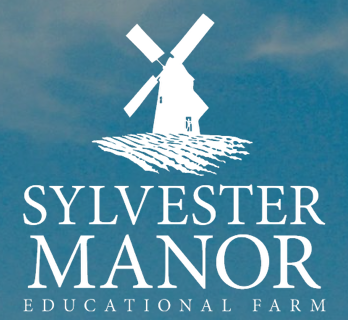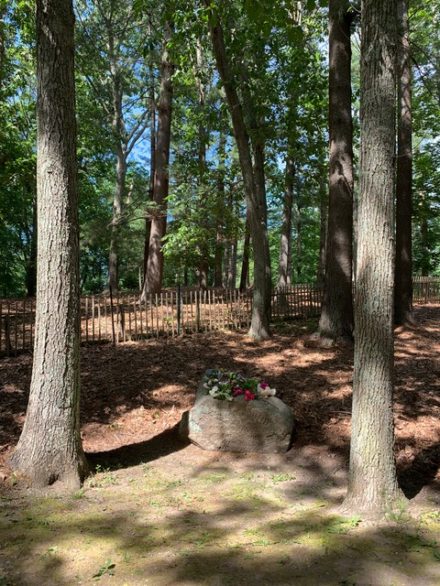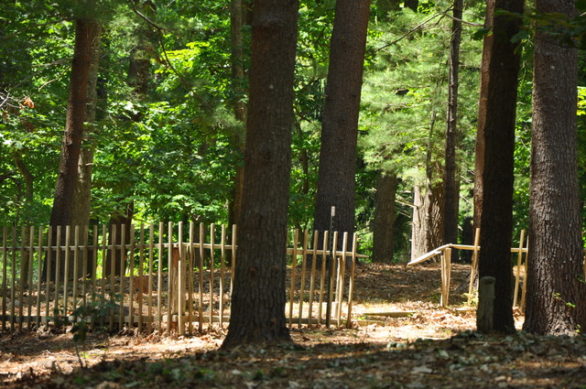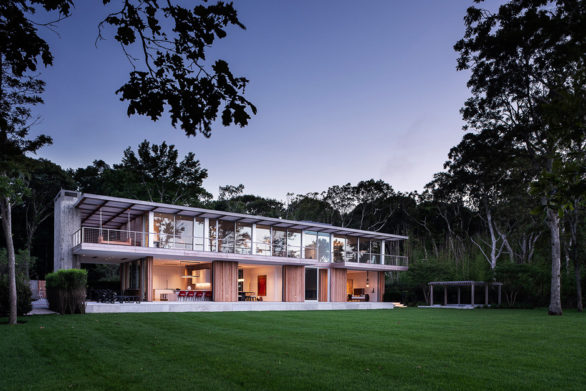
~~~~~~~~~~~~~~~~~~~~~~~~

AFRO-INDIGENOUS BURIAL GROUND REHABILITATION
Work begins on culturally significant site
Sylvester Manor Educational Farm announces it will begin Phase 1 of a rehabilitation project of its Afro-Indigenous Burial Ground. Through the use of ground-penetrating radar, it has been determined that the remains of as many as 200 people may be buried in the small rise of land between the driveway forks, surrounded by a timber fence and enshrouded by thick pine trees. Some of the graves appear to be marked by small glacial stones without inscriptions or other identifiers. The place is marked by a large boulder inscribed with the words, “Burying Ground of the Colored People of the Manor from 1651,” installed by the Horsford family ca. 1884. Ongoing non-invasive archaeological and archival study has revealed that there may be additional burials outside of the 19th-century fence boundary.

Donnamarie Barnes, Archivist/Curator of Sylvester Manor states, “The Afro-Indigenous Burial Ground at Sylvester Manor is a sacred place honoring the Native and Enslaved People who lived and worked at Sylvester Manor and who are considered the Ancestors of this Place.”

The ongoing rehabilitation will provide improved access and interpretation of the historic Burial Ground, enhancing opportunities to educate visitors about the history of enslaved labor at Sylvester Manor and the role of slavery and indenture in the northeastern United States. Sylvester Manor has worked extensively with an archaeological team from the University of Massachusetts Boston over the past 24 years to research and understand the people who worked and sustained the Manor. A continuation of this work, including a reexamination of the Afro-Indigenous Burial Ground was scheduled for the summer of 2020, but these plans were disrupted by the pandemic. While more archaeological study has been put on hold until 2021, Sylvester Manor Educational Farm is committed to revitalizating this area.
Starting in September, work is commencing to remove dead and fallen trees, clear out areas of dilapidated fencing and create a restful and reflective area that will welcome visitors walking the Manor grounds. The rehabilitation will further illuminate the cultural significance of the site, while protecting and improving the ecological integrity and health of the area, and providing a safe space for visitors to experience this powerful place.
The long-term phased plan will include enhanced wayfinding and circulation. A new pathway will connect the Afro-Indigenous Burial Ground to the nearby Barn Complex, inviting visitors to explore this important historical feature. A visually porous fence will follow ancient island topography, harkening to the long era of indigenous habitation before 17th century colonial settlement. The plan for this uniquely significant cultural landscape will allow adaptation to ongoing discoveries and evolving understandings of the site.
Stephen Searl, Executive Director of Sylvester Manor, states “Since its founding, Sylvester Manor has been dedicated to telling the stories and histories of all the people of Sylvester Manor — the Indigenous Manhansett People, the colonial European Sylvester Family and descendants, and the Enslaved Africans brought to Shelter Island against their will. By rehabilitating this culturally significant site we are improving the interpretation of Sylvester Manor’s history and providing a place for our visitors to experience the history of those who built and sustained this place.”
Support is needed to continue this important work. To learn more or to donate, please visit https://www.sylvestermanor.org/the-grounds or email us at info@sylvestermanor.org.
~~~~~~~~~~~~~~~~~~~~~~~~~~~~~~~~~

About Sylvester Manor Educational Farm: Once a Native American hunting, fishing and farming ground, Sylvester Manor has since 1652 been home to eleven generations of its original European settler family. It reflects a remarkably intact history of America’s evolving tastes, economies and landscapes. Over time, the place has been transformed from a slaveholding provisioning plantation to an Enlightenment-era farm, then to a pioneering food industrialist’s estate and today to an organic educational farm responsive to, and supported by, our neighbors and friends worldwide. In light of this history, we envision a farm, a community, and a world where people celebrate food, arts, and inventiveness in the everyday, with a spirit of fairness and joy.
——————–
Photo courtesy of Sylvester Manor Educational Farm
—————-
==========================================


AAQ / Resource: Stelle Lomont Rouhani Architects
______________________________________________________________
